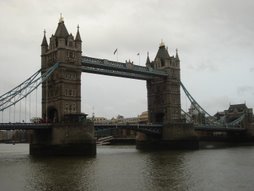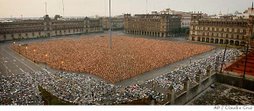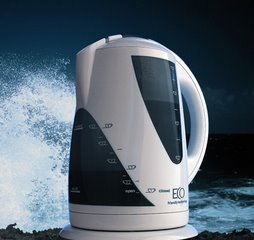Pues ayer hice el tan esperado examen de certificaciond e Ingles del tec, el resultad lo sabre el 3 de Octubre, asi que los mantendré actualizados, y pues para aquellos que quieren saber de que trato, el texto principal era el que viene abajo y de ahi habian varias preguntas como de comprension con respecto a lo leido y tambien tuve que hacer un como resumen de las ideas principales. Pero me parecio bastante interesante el articulo, hasta venian cosas de Inglaterra.
He aqui el article
Solar Technology - The Sun As Our Energy Supplier
There are different ways in which the sun’s power can be used. Solar thermal energy is obtained by converting solar heat into useful heat, for warming shower water or heating, for example. Photovoltaics means converting solar radiation into electrical energy. In order to do so, individual solar cells are combined to create solar modules.
Solar cells consist of a semi-conductor material (generally silicon) in which light irradiation is separated into negative (electrons) and positive charge carriers. An electric field created by selected imbalances in the semi-conductor separates the charge carriers. The result is a lack of electrons on one side and a surplus of them on the other. This electrical tension can be collected with a metal contact on the upper and lower sides.
The French physicist, Alexandre Becquerel, discovered the photovoltaic effect, by which pairs of electrical charge carriers are separated when hit by sunlight, in 1839. In 1884, the American Charles Fritts described the electromotive force in illuminated selenium and constructed the first solar cell. Its effectiveness was, however, minimal.
The scientific explanation for the fact that light can be converted directly into electricity was provided by Albert Einstein in 1905. His essay on the law of the “photoelectric effect” from 1905 supplied the foundation for modern photovoltaics.
In the end it was a coincidence which led to the modern solar cell. Calvin Fuller and Gerald Pearson were actually developing the transistor and created the solar cell almost as a by-product of an experiment. Together with their colleague Darryl Chapin, the researchers presented their silicon-based "Solar Energy Converting Apparatus" in 1953. The breakthrough had been made. As early as 1958, the first satellite fitted with a photovoltaic energy device was floating through space. Today, energy supplied by photovoltaic modules is standard for spacecraft.
At first, photovoltaics remained an expensive form of technology used only for special applications. But then the oil crisis in 1973 and the Chernobyl reactor catastrophe in 1986 spurred on the search for new, regenerative sources of energy. The conversion of sunlight into electricity and warmth experienced a real boom and, finally, became affordable for private households.
Nowadays, thin-film solar cells are being produced. They are particularly cost-effective as only very little silicon is required to make them. The cells are vapor deposited onto a medium such as glass and can then be installed easily on facades for instance.
Wind power - From Air Currents to Electrical Currents
Wind energy plants work on the principle of aerodynamic force. The wind striking the rotor blade creates positive pressure below the sail, whilst there is negative pressure above the sail. This pressure differential generates a lifting force which modern wind energy plants utilize for movement and thus for electricity production.
Force 3 winds, which are common over the North Sea, the southern tip of South America, the Australian island of Tasmania and the Great Lakes in the north of the USA and other areas, are especially advantageous for wind energy plants. It merely remains to harness this wind. Measurements made by US-American researchers in 8,000 locations have shown that we could meet the world’s electrical energy requirements with wind power – on the condition that we use it more effectively.
In February 2005, the largest wind energy plant in the world began operation in Brunsbüttel in Germany. The 183 metre high giant "REpower 5M" has a rotor diameter of 126 metres which sweeps across an area of two football fields per revolution. The plant can provide up to five megawatts of electricity which is enough to supply around 4,500 households – an achievement which is unmatched worldwide.
Suitable areas for large wind power stations are, however, scarce – therefore great hopes are being placed in wind power plants at sea. Worldwide, some offshore wind parks have now been set up, for example in Denmark, Sweden, the Netherlands, Germany and England. The fact that the energy yield at sea is around 50 percent higher is due, amongst other factors, to the fact that water surfaces offer almost no friction to the wind. From a technical point of view, however, the offshore plants are considerably more costly than wind power stations on land because they have to brave high waves, storms and ice. This makes them around 60 percent more expensive than comparable onshore wind parks. In addition, the offshore power stations produce low frequency sounds which could drive away birds, fish and marine mammals.
The idea of a flying wind park sounds like something from science fiction. It would have two rotors and produce electricity at a height of five kilometres where strong, regular winds blow. The flying power station would be held by a cable which would also transport the electricity gained to the ground. It would take to the skies in a way similar to a kite and remain stable once in the air. However, it is still wholly uncertain whether this kind of airborne wind park will ever be built.
Water Power – Energy from Rivers and Seas
The first hydroelectric power stations for the production of electricity were built in England as early as 1880. Today there are river power plants, storage power plants, pumped storage power plants, tidal power stations and wave power stations. But as different as these various types of hydroelectric power station are – they all function in similar ways: a power station generally consists of a weir or dam which stores the water in front of the power station or in a reservoir located on higher ground. From here, the water enters the supply pipe or penstock via the intake. Depending on the type of the turbine, either potential or kinetic energy drives a turbine which is connected to a generator. This finally transforms the mechanical energy into electricity. If the water has passed the turbine it is channeled back into the natural course of the river or the equalising reservoir.
Modern “water wheels” such as the Francis or Pelton turbine can convert almost all of the water power into mechanical energy. They can attain 95 percent efficiency.
Wave power stations
The power of the seas can also be used to produce energy. A wave power station on the Scottish island of Islay has been providing electricity since 2001. The technology is actually quite simple: it is not the water which creates energy but the air which the water displaces. The plant consists of a pipe-shaped reservoir which reaches under the surface of the water. The water level rises and falls with the waves and the air in the pipes is pushed upwards or sucked downwards. The air flow which this creates powers the Wells turbines, named after their inventor. These turbines are remarkable in that they turn in the same direction whether there is an inflow or outflow of air. Optimum use of wave power is achieved as the turbo generator driven by the turbines also supplies electricity when the waves subside. In this way, the “Limpet 500” produces 500 kilowatts – enough for around 400 households.
Saturday, September 29, 2007
Posted by
Ceci
at
12:14 PM
![]()
Subscribe to:
Post Comments (Atom)






































No comments:
Post a Comment